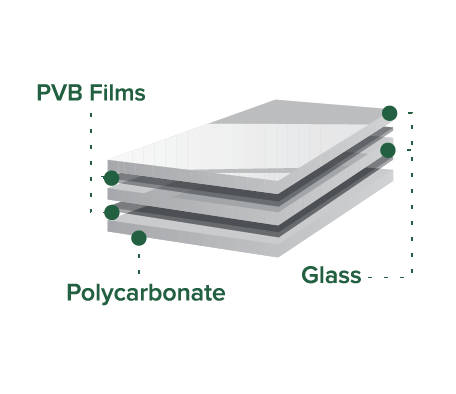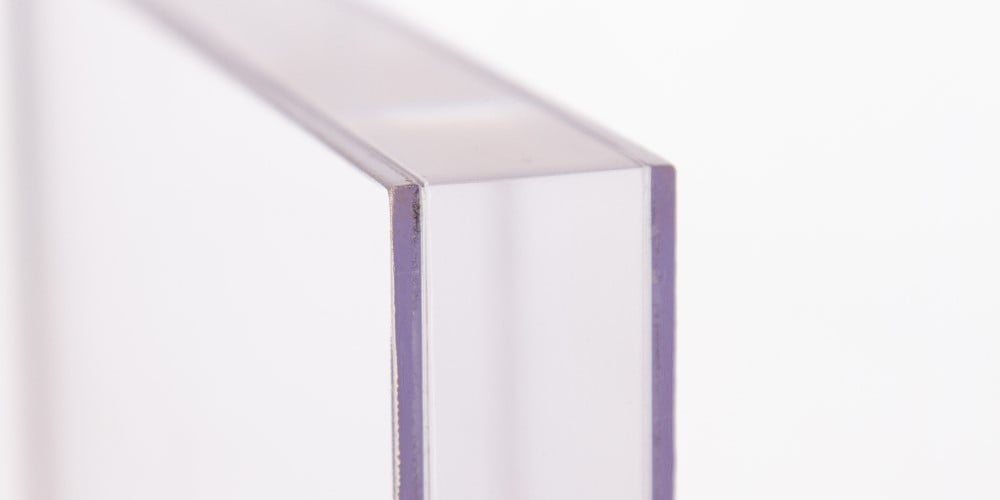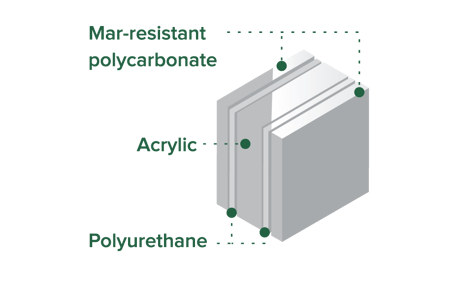Business owners and organizations are increasingly considering ballistic polycarbonate glazing for their exterior windows, interior windows/barriers, entryways, and reception areas. But it can be hard to separate viable options from hype and determine what approach and materials are right for increasing safety and security in your building.
What Is Polycarbonate Glazing?
Although polycarbonate is a popular material for ballistic barrier systems, not all polycarbonate is ready to stop a bullet.
Polycarbonate is an extremely common thermoplastic, often sold under trade names like Lexan, Makrolon, Cyrolon, and Merlon. It's easily worked, hard to crack, and can be readily molded using heat. Polycarbonate is far more resilient than other glazing materials—and, in fact, far more resilient than other plastics. For example, clear polycarbonate can absorb an impact two times more powerful than either ABS (the hearty plastic used for the casings of power tools) or PVC (the rigid plastic used for non-metallic plumbing).
These properties make polycarbonate extremely popular. In a given day, you probably make use of hundreds of pieces of polycarbonate, from prescription and safety eyeglass lenses to outdoor light fixtures, electronic displays, auto headlights, sneeze guards, and more.
Polycarbonate glazing offers several key advantages. It isn't just more impact resistant than any other glazing option, but also lighter and thinner, often making it easier (and thus less expensive) to fabricate and install. Unlike most thermoplastics (and certainly glass), polycarbonate can withstand fairly large deformations without cracking. In a ballistic context, this lends itself to a "no-spall" barrier (that is, one that doesn't eject sharp chips or shards when shot).
But it has its downsides. Polycarbonate, by itself, has high impact resistance but poor scratch resistance. It also has poorer light transmission than other transparencies and the layering required to make it bullet-resistant further lowers its clarity.
That said, even though polycarbonate glazing is made from "plastic," it doesn't tend to feel "plasticy." The makeup of bulletproof polycarbonate glazing is such that it still looks and feels like traditional window glass to most casual observers.
Is Polycarbonate Bulletproof?
Just to be clear, nothing is truly 100% "bulletproof," but rather "bullet resistant" or "ballistically rated" to withstand a certain number of bullets of a given caliber shot from a specific distance and angle. All true bullet-resistant materials have been tested by an OSHA-designated third-party NRTL (Nationally Recognized Testing Laboratory) that has confirmed that the material meets the criteria of a defined specification, like UL 752. For example, "UL Level 3" bulletproof polycarbonate glazing will stop no fewer than three shots from a .44 Magnum pistol (or a similar number of shots from a smaller caliber pistol). Level 8 polycarbonate glazing will stop a spray of five shots from a 7.62 tactical rifle (i.e., an "AK-47 assault rifle," or similar weapon).
In order to make polycarbonate glazing bullet resistant, glass makers laminate together multiple layers of 1/2- and 1/4-inch polycarbonate. When a bullet strikes a window made from these laminated layers, the dense and pliable polycarbonate "sucks" the bullet in, safely locking it up inside the layered plastic like a bug in amber.
Because all ballistic polycarbonate glazing is laminated, you have the opportunity to "tune" the material with many different make-ups. For example, some polycarbonate make-ups (like LP 1250 BR) include both polycarbonate (for strength) and acrylic, to capture some of that desirable optical clarity. Other make-ups, like "glass-clad polycarbonate", are optimized for exterior use (which is otherwise not a strong suit for polycarbonate glazing). Of course, it's hardly worth asking "Is polycarbonate bulletproof?" if you're going to mount that window in a wall or frame that is not. This is why the best bulletproofing companies, like Total Security Solutions, always take an all-hazards "systems" approach to each installation, being sure to include true UL-rated bulletproof window framing and wall-reinforcing panels as needed.
Of course, it's hardly worth asking "Is polycarbonate bulletproof?" if you're going to mount that window in a wall or frame that is not. This is why the best bulletproofing companies, like Total Security Solutions, always take an all-hazards "systems" approach to each installation, being sure to include true UL-rated bulletproof window framing and wall-reinforcing panels as needed.
What’s the Difference Between Bulletproof Polycarbonate Glazing and Acrylic?
Because polycarbonate and acrylic can be used nearly interchangeably in many applications (for example, in many non-security building applications), people often inadvertently assume they are the same material under two different names.
That is not remotely the case.
Clear acrylic sheets are commonly sold under names like Plexiglas, Lucite, Acrylite, and Perspex. While this is also a thermoplastic, it's very different from polycarbonate.
Acrylic is a fundamentally hard and rigid plastic, with extremely high light transmission, lending it potentially dazzling clarity. Polycarbonate, by comparison, is softer, more flexible, and has somewhat lower light transmission.
In ballistic applications, acrylic is often used in a single thick "monolithic" sheet 1.25 to 1.5 inches thick. Ballistic polycarbonate, on the other hand, is never monolithic. Instead, it's created by laminating thinner sheets of standard polycarbonate, maximizing its inherent impact-resistance to the point that it becomes bullet resistant. As a result, ballistic polycarbonate glazing can offer comparable bullet resistance to acrylic at almost half the thickness and weight, while simultaneously offering shatter-, forced entry-, and blast-resistance.
When a bullet strikes acrylic, it pancakes against the hard face of the plastic and transfers an enormous amount of force to the acrylic. Instead of breaking, the acrylic absorbs this force by cracking across its surface in a dense spider web and throwing off many small chips and shards (called “spall”).
According to Total Security Solutions CEO Jim Richards, "At one time, we did a lot of monolithic acrylic. But monolithic acrylic is really only good against smaller caliber pistols, and I think the threats many organizations face now, that wasn't helping them feel safer. Meanwhile, laminated materials like LP 1250 can have a high acrylic content, for better aesthetic characteristics, but include layers of polycarbonate to increase the performance."
Backglazing with Bulletproof Polycarbonate
In physical security, "backglazing" refers to installing a layer of ballistic polycarbonate glazing on the interior side of your existing window. This creates a transparent backstop to catch bullets without disturbing the exterior of the building.
“People love backglazing with polycarbonate," Jim explains. "You address your security concerns, but don’t have to worry about messing with the facade of the building. It saves a lot of work and hassle, compared to removing frames from an existing building and then replacing them. If you're securing exterior windows on an upper story, going with something like our TSS Removable Backglazing System can easily shave 25% of a project cost. On a big job, you can go from closing down the street for a full business day, bringing in cranes and riggers and pulling permits, to maybe moving a few desks before you leave for the night."
TSS is always ready to help you reduce the hassle of increasing your security and safety with bulletproof polycarbonate glazing. Contact our ballistic security experts today if you have questions or want to get started with a specific project or begin exploring options on your own using the 3-Part Specs and Data Sheets available on our website.


